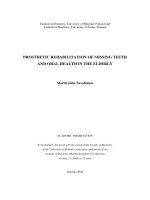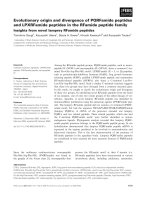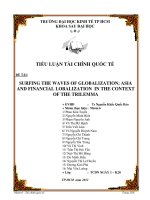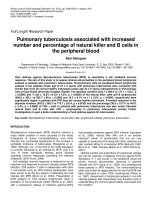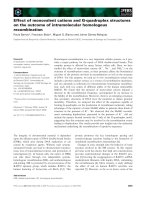EFFECT OF ANIONS, CATIONS AND IONIC STRENGTH IN THE BATH ON THE cr (III) ELECTRODEPOSITION ẢNH HƯỞNG của ION DƯƠNG, ION âm và NỒNG độ ION TRONG bể mạ đến QUÁ TRÌNH mạ điện cr (III)
Bạn đang xem bản rút gọn của tài liệu. Xem và tải ngay bản đầy đủ của tài liệu tại đây (732.71 KB, 9 trang )
Kỷ yếu hội nghị khoa học và công nghệ toàn quốc về cơ khí - Lần thứ IV
EFFECT OF ANIONS, CATIONS AND IONIC STRENGTH IN THE BATH ON
THE Cr (III) ELECTRODEPOSITION
ẢNH HƯỞNG CỦA ION DƯƠNG, ION ÂM VÀ NỒNG ĐỘ ION TRONG BỂ
MẠ ĐẾN QUÁ TRÌNH MẠ ĐIỆN Cr (III)
Eng. Nguyen Van Tai1a, Prof. Jing - Chie Lin2b, Dr. Nguyen Van Cuong1c
1
College of Engineering Technology, Can Tho University, Viet Nam
2
Nation Central University, Taoyuan City, Taiwan
a
; ,
ABSTRACT
In this study, the effect of background electrolyte and the ionic strength on
electrochemical deposition of chromium using trivalent chromium baths is considered.
Candidate baths were first chosen after a series of testing in Hull cell, then they were
conducted by using direct current electroplating potentiostat in the bath. The working
potentials of this process and quality of the chromium deposits were considerably depended
on the ionic strength of the baths as well as different source of anions and cations. Sequences
of electrochemical plating were performed to investigate the optimal range of ionic strength,
and to get the most suitable kind of anions and cations for the popular baths containing
trivalent chromium. The results showed that the conditions in which the ionic strength within
a range of 7.75 to 10.75 (sodium sulfate in the range from 0.25 M to 1.25 M, magnesium
sulfate in the range from 0.19 M to 0.94 M), the pH of the bath from 1.5 to 2.0, bath’s
temperature from 30°C to 35°C, current density within the range from 4.5 to 7.0 A/dm2, the
satisfying Cr-coatings were obtained with a thickness of several tens of micrometers, revealed
a good appearance with a smooth and good luster surface.
Keyword: ionic strength, sodium sulfate, electrodeposition, trivalent chromium,
corrosion resistance.
TÓM TẮT
Nghiên cứu này trình bày ảnh hưởng của tính chất dung dịch mạ và nồng độ của các ion
trong dung dịch lên quá trình mạ điện hóa Crôm trong bể mạ chứa ion Cr3+. Trước tiên, những
bể mạ sẽ được lựa chọn sau loạt thí nghiệm sử dụng thiết bị Hull Cell (gồm 2 điện cực: điện
cực âm và điện cực dương), sau đó những bể mạ phù hợp sẽ được thực hiện với việc sử dụng
dòng điện trực tiếp trong thiết bị điện hóa potentiostat. Điện thế (DC) được sử dụng cho quá
trình mạ điện hóa và chất lượng của lớp mạ Crôm phụ thuộc đáng kể vào nồng độ của ion
trong dung dịch, những loại ion dương và ion âm khác nhau. Quá trình mạ điện hóa được tiến
hành riêng biệt và theo trình tự để xác định khoảng nồng độ tối ưu của các ion, từ đó chọn ra
được những ion âm và ion dương phù hợp cho quá trình mạ điện hóa với bể mạ chứa ion Cr3+.
Kết quả chỉ ra rằng, ở điều kiện nồng độ của các ion trong dung dịch từ 7.75 đến 10.75 (tương
ứng với nồng độ natri sulphate từ 0.25 M đến 1.25 M, nồng độ magnesium sulphate từ 0.19 M
đến 0.94 M), độ pH của bể mạ từ 1.5 đến 2.0, nhiệt độ bể mạ từ 30°C đến 35°C, mật độ dòng
điện trong khoảng từ 4.5 đến 7 A/dm2, lớp mạ Crôm thu được đạt chất lượng với bề dày lớp
mạ khoảng vài chục micrometer, cùng với lớp bề mặt mạ sáng bóng và đồng đều.
Từ khóa: nồng độ ion, natri sulphate, mạ điện hóa, Cr3+, sự chống ăn mòn.
243
Kỷ yếu hội nghị khoa học và công nghệ toàn quốc về cơ khí - Lần thứ IV
1. INTRODUCTION
Hard chromium coatings were widely applied in various industries to improve hardness,
wear ability, corrosion resistance and decorative appearance of mechanical parts and
instruments. Chromium coatings were usually deposited using conventional highly toxic
hexavalent chromium process. Although the traditional hexavalent chromium electroplating
process is simple and low-cost with small amount of H2SO4 or fluoride as catalysts, its serious
health and environmental problems making the hexavalent chromium deposition process faces
to environmental strictly considerations through-out the world, resulting hexavalent
chromium electroplating can be possible extinction [1-2]. In the past decades, continuous
investigations have been done to find out a new technology that replaces the for the
conventional hexavalent bath for their less toxic properties. The attempts have been pointed
out trivalent chromium bath is a suitable alternative with a good quality deposited coating.
However, trivalent chromium process stills has problems that need to be solved to extend
range of applications for this technology. Firstly, it is difficult to get the high current
efficiency because the rate of Cr electrodeposition was reported to be rapidly diminished with
deposition time and after several tens of minutes of electrolysis no mass gain [3]. Secondly,
trivalent chromium plating process is unable to get the thick chrome coatings, making the
deposits unsuitable for hard chromium, wear-resistance and other functional applications [4].
Moreover, amount of pinholes and cracks on coating surface are main channels to chloride
ions penetrating into surface and corrode the coating. These problems restrict the application
and expansion of the Cr3+ plating process [5].
In electrodeposition process, organic additives have played important roles to improve
characteristics of coating surface such as roughness surface, cracks, brightness and packing
factor. There are many various organic and inorganic additives, such as formaldehyde, methyl
alcohol, form amide, were added into chromium electrolytes to examine the effect of additives
to coatings. The content of carbon reduction and the organization of carbon particles in the
deposits depend on the organic additive nature. The electro-chemical behavior was
significantly controlled by the formation of chromium coatings from different organic
additives. The behavior of various inorganic compounds was investigated, he pointed out the
inorganic additives increase the solution conductivity, decrease deposition time, low throwing
power, and give a better roughness surface and brightness [6 - 9]. Trivalent chromium
electroplating occurred two continuous reduction steps, Cr3+ ion → Cr2+ ion (at E0 = - 0.41 V
vs SCE) and then from a Cr2+ ion to Cr(s) (E0 = - 0.91V vs SCE).
+𝑒−
𝐶𝑟 3+ →
+2𝑒−
𝐶𝑟 2+ →
𝐶𝑟(0)
(1)
During the trivalent chromium deposition process, the formation of Cr2+ ions as known
as cathodic film (CF) was very important and was directly controlled by diffusion process.
The formation of the CF is based on adsorbed oxo-hydroxo complexes (OHC) such as
{[CrOp(OH)3-2p]q. xH2O}ads, where parameters p, q, and x depend on the electrolysis and
its duration. Cr2+ ions are formed and adsorbed onto cathode surface by equation (2):
[𝐶𝑟(𝐼𝐼𝐼)𝐻𝐶𝑂𝑂𝑚 (𝐻2 𝑂)𝑛 ]3−𝑚 + 𝑒 → [𝐶𝑟(𝐼𝐼)𝐻𝐶𝑂𝑂𝑚 (𝐻2 𝑂)𝑛 ]2−𝑚
𝑎𝑑𝑠
(2)
After discharge of chromium ions, the released ions (HCOO−, H+) and H2O molecules
were diffused to the bulk solution via the adsorption layer. The formation of the new
adsorptive layer were slower than the diffusion of ions from CF to solution. This reduces
adsorption on the cathode surface and CF acts a barrier that hinders the penetration of ions
into the cathode surface. So, the thickness of adsorption layer is an important factor for the
diffusion of release ions and re-absorption of ions in trivalent chromium process.
In this study, we try to invest and explain the effect of various kind of anions and
cations as well as ionic strength on trivalent chromium electrodeposition to overcome the
244
Kỷ yếu hội nghị khoa học và công nghệ toàn quốc về cơ khí - Lần thứ IV
stilling problems (current efficiency, anticorrosion,...) and find out the suitable inorganic
additives for Cr (III) deposition process with varying the ionic strength.
2. EXPERIMENTAL METHODS
The chemical compositions of the baths were summarized in Table 1. The solutions
were heated to 700C in 2 hours to promote equilibrium state and kept in room temperature 24
hours to reach the thermodynamically stable form with completely Cr(III) complex ions
formation before deposition. The pH = 1.7 of solution in bath was controlled by adding of
NaOH or HCl.
Table 1. Composition of the baths containing the different inorganic additives.
Firstly, candidate baths were conducted under a series of testing in Hull cell of 250 ml
with the platinized titanium (50x65) as anode, Cu sheets (65x100) as cathode, current of 2 A
at 30°C in 10 min. The range of ionic strength was determined based on the length of bright
coating. The current densities were preliminary calculated by equation (3).
𝐼𝑐 = 𝐼(5.1 − 5.24 𝑙𝑜𝑔𝑥𝑐 )
(3)
Where: Ic - cathode current density [A/dm2]; I - total current in the cell [A]; xc coordinate along the cathode [cm].
Secondly, the electrodeposition was conducted by using direct current electroplating
potentiostat in the bath with the platinized titanium, Cu foils as anode and cathode,
respectively.
To evaluate the effect of anions and cations, the electroplating was carried out under
potentiodynamic polarization with potential from -0.2 V to -2.5 V and chronopotentiometry
with current density of 5 A/dm2, pH = 1.7 in bath at 30°C for 15 min.
To examine effect of current density on current efficiency, the current density was set
from 4 to 7 A/dm2 for the best source of anion, cation and ionic strength in the same
conditions. After electrodepostion, the coatings were clearned / rinsed by distilled water and
dried by N2 gas at room temperature.
To access anti-corrosion of the coatings, all coatings were examined using potentiodynamic polarization in a standard three-electrode cell using platinized titanium electrode and
245
Kỷ yếu hội nghị khoa học và công nghệ toàn quốc về cơ khí - Lần thứ IV
Saturated Calomel Electrode (SCE) as auxiliary and reference electrodes, respectively. The
potentiodynamic polarization tests were carried out using an EG&G potentiostat / galvanostat
(model 273A) with Powersuite software, at a scan rate of 1 mV·s−1 and applied potential range
from OCP to −600 and +400 mV in the cathodic and anodic directions, respectively.
The current efficiency were calculated by comparing the weight of specimen before and
∆𝑚
after experiments (𝜂% = 𝑚𝑚𝑒𝑎𝑠𝑢𝑟𝑟𝑒 ∗ 100).The average values of current efficiency were
𝑡ℎ𝑒𝑜𝑟𝑦
recorded from more than 3 independent measurements.
3. RESULTS AND DISCUSSION
3.1. Effect of Ionic Strength on Bright Range Examination
Figure 1: Bright and current density range
of the copper after “Hull cell” experiments
in different ionic strengths in conditions of
pH = 1.7; T = 30°C and current = 2 A.
(a) 7.00;
(b) 7.75;
(c) 8.50;
(d) 9.25;
(e) 10.00;
(f) 0.75;
(g) 11.50
The bright range of coatings under Hull cell test for different ionic strength solution are
shown in Fig 1. It reveals that ionic strength clearly influences to bright and current density
range. For free solution at ionic strength 7.00, bright range of coating is seemly footling and
shows a dull coating. It can be attributed to the formation of thick adsorption layer on
electrode surface that acts as steric hindrance of diffusion process of released ions and readsorption layer on surface leading to the reduction of Cr3+ ion cannot occur continuously.
When ionic strength increases gradually from 7.75 to 11.50, the range of bright coating and
current density are significantly improved comparing with free solution. However, the narrow
bright and large burning coating appear on surface at ionic strength 11.50 due to the increase
of solution’s conductivity at high ionic strength. Thus, ionic strength from 7.75 to 10.75 is
suggested as suitable values for trivalent chromium electrodeposition process to obtain a
bright coating and optimal current density range.
3.2. Effect of Anions and Cations on Potentiodynamic Polarization
Figure 2 shows the polarization curves from -0.2 V to -2.5V depended on various
electrolyte with different sources of anions and cations at the same ionic strength 10.75. As
mentioned above, the reduction of Cr3+ ion occurred via 2 steps, this is evidently confirmed in
Fig 2 (a, b, c, d, e and f). During scanning, there are 3 regions (A, B, C) are observed for Cr
(III) electrodeposition process, exception the electrolyte contain NO3- anion.
In region A (Fig 2b), from - 0.2 to 0.71 V, there is a slight increase of cathodic current
reflecting to no phenomena occurs on the cathode surface. In region B, from - 0.72 to 1.34 V, the current begins to increase significantly in this potential range, this indicates the
reduction reaction of Cr3+ ion has happened. An electroplating experiment using Cr3+ - Na+
solution at 30°C, pH 1.7 in 15 min with a constant potential of -1.30 V was conducted to
examine the deposition reaction. The result showed that there was no deposit at this potential.
The result could be ascribed to the reduction of Cr3+ to Cr2+, the first step of trivalent
246
Kỷ yếu hội nghị khoa học và công nghệ toàn quốc về cơ khí - Lần thứ IV
chromium reduction, indicating that the reduction of Cr2+to Cr0 did not occur. The reduction
of Cr3+ to Cr2+ was controlled by a diffusion process via the absorption layer. In region C,
when the potential increased to be more negative than -1.34 (3.8 A/dm2), the cathodic current
increased rapidly. This showed that another reduction reaction had occurred and the mass
increased on the cathode surface. Another electroplating experiment with the same conditions
at -1.5 V was performed. Chromium coating was deposited on substrate at this potential,
which could be assigned to the reduction of Cr2+ to Cr0, the second step of trivalent chromium
reduction. For cases of free solution, Cr3+ - Mg+2 solution, Cr3+ - Al+3 solution and Cr3+ PO43- solution, the results showed the same tendency with solution containing Na+ ion with 3
region of this potential, but the different potential range and current density for each range
were found. In region C, the beginning potential for Cr(III) deposition was -1.38 V (4.7
A/dm2), -1.33 V (3.3 A/dm2), -1.32 V (5.5 A/dm2) and -1.63 V (13.1 A/dm2) for free solution,
Cr3+ - Mg2+ solution, Cr3+ - Al3+ solution and Cr3+ - PO43- solution, respectively. This can be
attributed the various kind of source of anions and cations that were added into solution and
the different configuration of adsorption layer were formed on electrode surface leading to
change of potential and current density. For Cr3+ - NO3- solution (Fig 2 e), in region A’, nitrate
reduction occurs at cathode (-0.61 V) to form nitrite and hydroxide ions that shows in
Reaction (4). It causes a significant increase in pH value at cathode leading to in the formation
of olation, polymerization and precipitation processes of Cr3+ ions that prevent strictly the Cr
(III) deposition process.
𝑁𝑂3− + 𝐻2 𝑂 + 2𝑒 − → 𝑁𝑂2− + 2𝑂𝐻 −
C
(4)
C
C
B
A
A
B
A
B
C
C
C
B
B
A
B
A
A’
A
Figure 2: Potentiodynamic polarization curves for various electrolytes at conditions:
scan rate = 1 mV/s, pH = 1.7, T = 300C
3.3. Effect of Anions, Cations and Ionic Strength on Current Efficiency
Figure 3 shows that the current efficiency depends sharply on ionic strength as well as
source of anions and cations. It is easily recognized that Na+ and Mg2+ ion are appropriate
series of cations for Cr (III) electro-deposition process. For solutions containing Al3+ ion, the
current efficiency is very low and change insignificantly in increase of ionic strength. It can
be explained that a co-deposition (Al3+ and Cr3+ ion) occurs at cathode when potential is more
negative than -1.35 V. The reduction of Al3+ ion was measured at suitable voltage bias lies
247
Kỷ yếu hội nghị khoa học và công nghệ toàn quốc về cơ khí - Lần thứ IV
between -1.0 V and -1.25 V versus SCE and then Al metal combined with oxygen to form
aluminum oxide thin film. This film has a high stability and acts as an excellent surface
passivation leading to limit deposition process. Thus, the current efficiency is so worse in Cr3+
- Al3+ solution. This diagram also indicates that the current efficiency with Cr3+ - Na+ solution
is higher than that of Cr3+ - Mg+ solution at the same ionic strength. The Na+ ion is believed as
the best cation to get the high current efficiency in trivalent chromium deposition process.
This might be attributed the competition between ions at adsorption layer, resulting the
different compositions of adsorption layer that amount of Cr3+ ions decrease with higher
valence of added cations. That caused a reduction of the current efficiency.
To evaluate the effect of anions on current efficiency, the solution of NN5 and NP5 were
prepared and performed to compare with SO42- ion at the same conditions with solution of N5
(current density – 5A/dm2, pH in bath – 1.7, temperature – 300C and time – 15 min). The
results shown that no coatings were found on surface for both solution contain of NO3- and
PO43- ion. As discussed in Fig 2, NO3- ion was added into electrolyte causing increase of pH
value at cathode during deposition process. The olation, polymerization and precipitation
processes have happened for Cr3+ ion instead of deposition. For Cr3+ - PO43- solution, the
viscosity of solution rises dramatically comparing with solution of N5 and insoluble deposits
would be produced [24]. Therefore, SO42- ion is a good anion for Cr (III) electroplating to
obtain a homogeneous and smoother surface with high current efficiency.
Figure 3: Effect of cations and ionic
strength on the current efficiency of
chromium electrodeposition in
different baths.
Conditions: pH = 1.7; T= 300C, current
density = 5 A/dm2, time= 15 min
Fig 3 also confirms that the suitable range of ionic strength is from 7.75 to 10.75 to get
a good coating with acceptable value of current efficiency. The highest current efficiency
obtains at ionic strength 10.75 (for Na+ and Mg2+ cations) with a remarkable value comparing
to free solution. It can be interpreted that ionic strength increases via rise of the total
concentration of ions in the bath, resulting in increase of the solution conductivity and
throwing power.
3.4. Effect of Current Density on Current Efficiency
Figure 4: Effect of current density on
the current efficiency of chromium
electrodeposition using solution of N5.
Conditions: pH = 1.7; T = 30 0C,
time = 15 min
In Cr(III) deposition process, the current efficiency as function of current density is
indicated in Fig 4. The current efficiency increases rapidly when cathodic current density is
more than 4 A/dm2 and increase continually in rise of current density. However, the current
density continues to accrete over 7A/dm2, the surface of coatings appear burning at edge of
samples and become worse. Thus, the optimal values of current density is suggested between
to be 4.5 and 7 A/dm2.
248
Kỷ yếu hội nghị khoa học và công nghệ toàn quốc về cơ khí - Lần thứ IV
3.5. Corrosion Behavior
The polarization curves of coatings in free solution and baths containing Na+ and Mg2+
ions at different ionic strength are shown in Fig. 5a, b and c, respectively. Fig. 5a shows the
deposited Cr coatings in the baths containing Na+ or Mg2+ ion have a lower corrosion current
comparing with Cr coating was deposited by free solution. The corrosion resistance of the
coating has been improved by addition of Na+ or Mg2+ ion. The nano-sized grain structure of
the Cr coating with reducing amount of pinholes or cracks may be contributed to the
improved corrosion resistance.
Figure 5. Comparison of polarization curve of different Cr coatings which
electrodeposited from free solution and solution contain of Na+; Mg2+ ions and varying
of ionic strength
Using Tafel extrapolation method, the corresponding electrochemical parameters were
extracted from polarization curves for Fig. 5 which were summarized in Table 2. As observed
in Table 2, the Ecorr for all the electrodeposited coatings is approximately from – 0.35 to −0.27
V. The coatings with ionic strength from 7.75 to 10.75 shows the no far difference of icorr
value for both of baths containing Na+ and Mg2+ ions. It can be explained that the electrolytes
contain of constant of formic acid concentration, which give a constant C content in deposits
because the percentage of C atom depends directly on concentration of formic acid. At a
higher formic acid concentration, the corrosion resistance will be remarkable enhanced due to
the high carbon content.
Anodic polarization curve shows the coating dissolution process. As it can be seen in
Fig. 5, a decrease in the chromium dissolution current for Cr coatings at E pass (from – 0.059 to
– 0.075 V) corresponds to the formation of passive film on the coating. But, as potential is
scanned toward positive direction, the anodic current begins to rise which indicates the
dissolution of the passive film. It indicated that this film is not stable which could be due to
the presence of micro-cracks or pinholes on the coating surface, they play as crucial path for
chlorine ions to penetrate and corrode leading to the relatively large current density in the
passivity region due to dissolution of the brass substrate rather than to dissolution of the
deposits. Moreover, the ipass is always larger than the icorr regardless of the concentration of
Na+ or Mg2+ ion. This is different from the metallurgical high-purity Cr, which displays an
ipass markedly lower than the icorr.
249
Kỷ yếu hội nghị khoa học và công nghệ toàn quốc về cơ khí - Lần thứ IV
Table 2. Corrosion parameters extracted from polarization plots with different
composition baths responding to ionic strength (IS) from 7.75 to 10.75
Electrochemical corrosion tests show that Cr coatings at ionic strength 10.75 exhibit
better corrosion resistance in 3.5 wt. % NaCl solution which is characterized by lower icorr.
This ionic strength also reveals that the higher current efficiency can be obtained at 10.75,
especially the bath contains Na+ ion as conducting salt.
4. CONCLUSION
Potentiodynamic polarization has confirmed that trivalent chromium electrodeposition
+𝑒−
+2𝑒−
process occur via 2 steps of reduction: 𝐶𝑟 3+ →
𝐶𝑟 2+ →
𝐶𝑟(0). The configuration of
adsorption layer plays an important role and is significantly influenced by source of anions
and cations. Hull cell tests point out the ionic strength from 7.75 to 10.75 is the suitable range
for deposition process. The current efficiency was clearly studied under effect of different
kind of anion, cation, ionic strength and current density. The results show that the electrolyte
contain of Na+ cation and SO2- anion at ionic strength 10.75 give the highest current
efficiency. The current efficiency increase rapidly in increase of current density. The coatings
were deposited in the bath containing added Na+ and Mg2+ ions had to be higher corrosion
resistance than free solution. However, the anti – corrosion of coatings are seemly similar
although they were conducted with different ionic strength.
ACKNOWLEDGEMENT
The authors acknowledge the financial support from the Ministry of Science and
Technology of Taiwan under contrast No. MOST 103-3113-E-008-003.
REFERENCES
[1]
J. H. Lindsay, Decorative and hard chromium plating. Plating and Surface Finishing,
1997, 84 (8), pp. 50–51.
[2]
Y. B. Song, D.-T. Chin, Current efficiency and polarization behavior of trivalent
chromium electrodeposition process. Electrochimica Acta, 2002, pp. 349–356.
[3]
I. Drela, J. Szynkarczuk, J. Kubicki, J. Appl, Electrodeposition of chromium from Cr
(III) electrolytes in the presence of formic acid. Electrochem, 1989, pp. 933.
[4]
YB. Song, DT. Chin, Pulse plating of hard chromium from trivalent baths. Plat. Surf.
Fin, 2000, Vol. 87 (9), pp. 80.
250
Kỷ yếu hội nghị khoa học và công nghệ toàn quốc về cơ khí - Lần thứ IV
[5]
W. Chien, et al., Microstructure and properties of carbon–sulfur-containing chromium
deposits electroplated in trivalent chromium baths with thio salicylic acid.
Electrochimica Acta, 2012, vol. 72, pp. 74–80.
[6]
J. C. Ballesteros et al., Zinc electrodeposition in the presence of polyethylene glycol
20000. Electrochim Acta, 2007, vol. 52, pp. 3686.
[7]
J. C. Ballesteros, et al., Composition, Structure, and Corrosion–Electrochemical
Properties of Chromium Coatings Deposited from Chromium (III) Electrolytes
Containing Formic Acid and Its Derivatives. Electrochem 2015, vol. 40, pp. 387.
[8]
T. Akiyama, S. Kobayashi, et al., Role of polyethylene glycol in electrodeposition of
zinc–chromium alloys. Electrochem, 2000, vol. 30, pp. 817.
[9]
Claudio Fontanesi, et al., Chromium electrodeposition from Cr (VI) low concentration
solutions. J Appl Electrochem, 2008, vol. 38, pp. 425–436.
[10] V. S. Protsenko, et al., Applying a theory of generalized variables to electrochemical
kinetics: interpreting the results of studying chromium deposition from Cr (III) baths.
Prot. Met., 2005, vol. 43, pp. 398–406.
AUTHOR’s INFORMATION
1.
Eng. Nguyen Van Tai, College of Engineering Technology, Can Tho University, Viet Nam.
Email: ,
2.
Prof. Jing - Chie Lin, Nation Central University, Taoyuan City, Taiwan
Email:
3.
Dr. Nguyen Van Cuong, College of Engineering Technology, Can Tho University
Email: , Tel.: 0989909034
251


